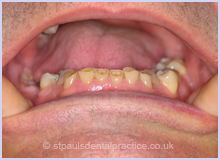Dental Crowns in Devon
Devon, TQ12 2HP
A Crown is an artificial restoration of a tooth to restore its function and give back its shape, contour and natural appearance.
Crowns can be made from plastic, ceramic or metal alloys. A combination of metal and ceramic can maximise strength and simulate the appearance of natural teeth.
Your dentist will prepare the tooth to an ideal shape for a Crown, usually under local anaesthetic. Once the tooth has been prepared, impressions are taken along with a shade to enable a good colour match. This information is then sent to a highly skilled dental technician, who makes your bespoke Crown. It takes two weeks for the Crown to come back to us ready for fitting.
Once the fit and appearance has been checked, the Crown is cemented in place.
The life of a Crown depends on how well it is looked after. The Crown itself cannot decay but decay can start from where the edge of the Crown joins the tooth.
You must practice good oral hygiene and maintain regular visits to the dentist/hygienist. It is very important to floss between the Crown and neighbouring teeth to ensure food debris and plaque are not left to endanger the longevity of your Crown.
We have a range of dental products to help your oral hygiene programme and can advise you how to use them effectively.







Please email us at info@stpaulsdentalpractice.co.uk or use the online form below.
* for compulsory fields.